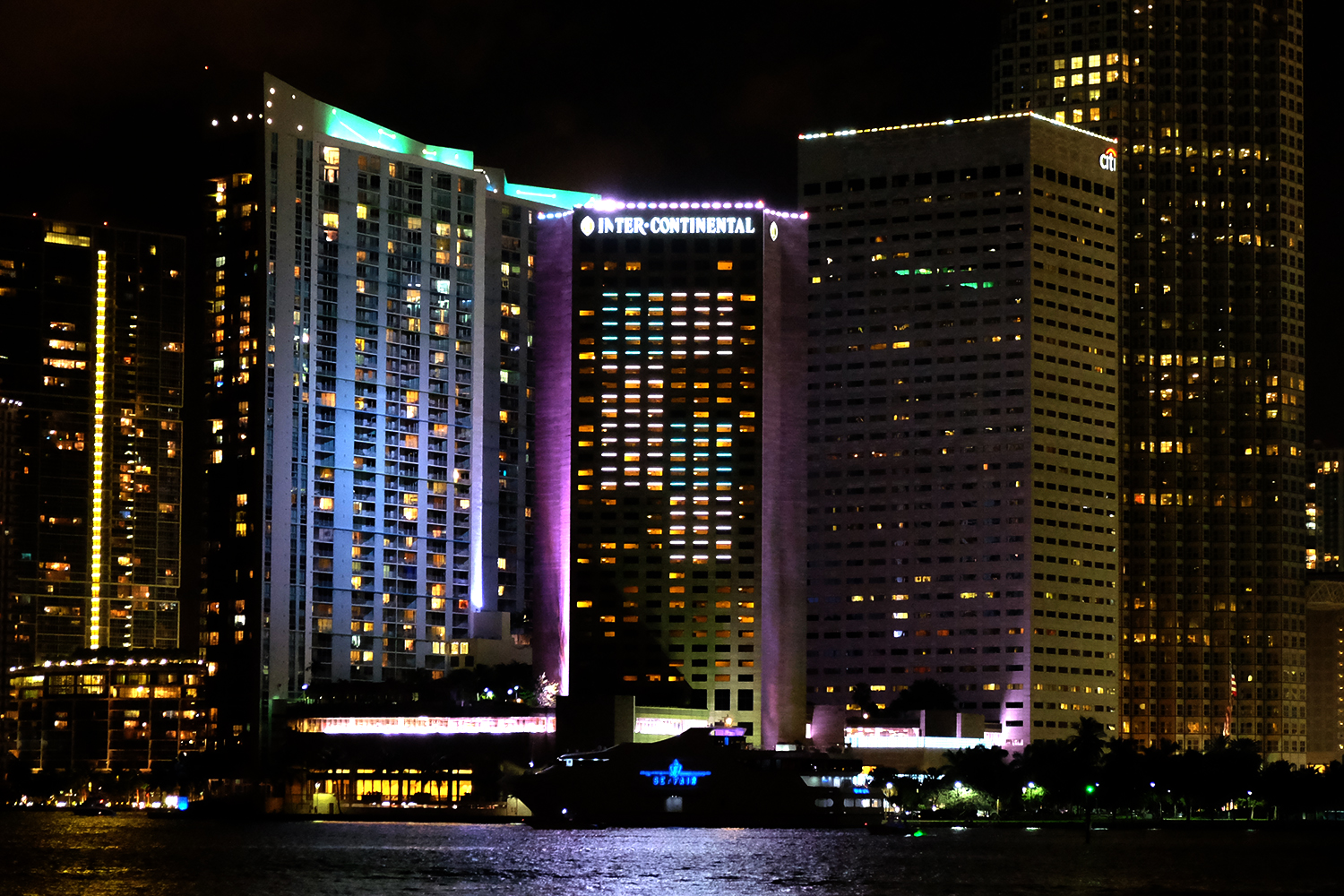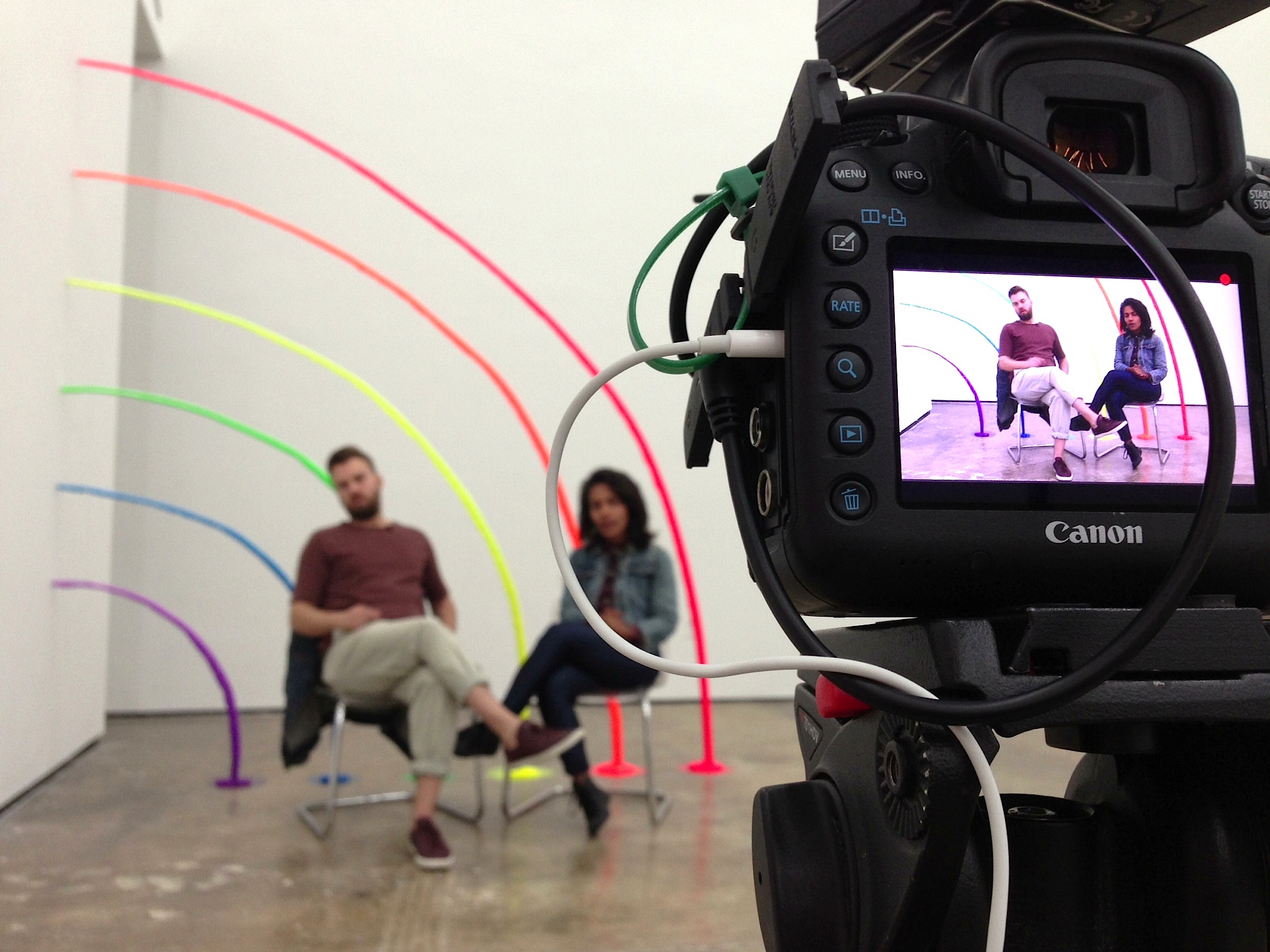
‘Newt Miami’: Light, color and sound animate the city’s skyline
Photo: “Newt Miami,” a public art installation on the InterContinental Miami. Photo by Sarah Moody, courtesy of “Newt Miami.”
Every night through Nov. 15, a series of “experiments in light, color and sound” will dance across the entire 19-story facade of the InterContinental hotel in downtown Miami. Described as performative architecture by the project’s creators, the installation, which is known as “Newt Miami,” takes inspiration from Isaac Newton’s theory and lifelong obsession with light.
Beyond the science, which I could spend all day getting lost in, “Newt” promises to bring more than flashy colors to Miami’s skyline. According to co-founder and producer Dejha Carrington, “Newt” will connect the community to the project with a series of ancillary events scheduled for this week, including a self-explanatory event called Caffeinated Conversations and a panel and Q&A session about transforming spaces through technology and art. Knight Arts Challenge winner Nu Deco Ensemble is the orchestra for the installation.

“Newt Miami” co-founders Dejha Carrington and Kelly Nunes at Primary Projects, with artwork by Gavin Perry. Photo by Peter Vahan, courtesy of “Newt Miami.”
What do you hope will be the cultural impact of “Newt”? How we choose to use our public and privately owned spaces plays a defining role in how we experience our communities and our social interactions. In the same way that my partner, Kelly Nunes, and I imagined the InterContinental Miami’s exterior facade as a canvas for an art installation, we hope that our creative take on performative architecture will inspire others to pitch their ideas, and will help illustrate the value of artistic collaboration to corporate groups.
Through social practice, there’s a unique opportunity to make residents and audiences participants and decision makers in the creative process. We’re interested in sparking more talk about the relationship between spaces, public art and locals, and how projects such as “Newt Miami: Experiments in Light, Color & Sound” can serve the dual purpose of activating a static structure and creating connections through meaningful programming and activities.
What were some of the unique challenges getting “Newt” up and running? There was a very real learning curve, both for us and the InterContinental Miami, because there was no precedent for such a project. Kelly and our team worked closely with them and Fresh Juice Global, their production and content support company, to push the existing technology beyond its intended use. “Newt” was built from the ground up and workshopped for almost one year before we even knew what was possible with the digital canvas.
Why are public art projects like “Newt” so important for urban communities? “Newt” is an example of how individuals and creatives have the capacity to reshape a cultural narrative. The “Newt” installation is temporary, but we’re using this project to shine light on bigger topics such as urban planning, placemaking and public art, and have created a platform where new ideas and connections can begin to gel and solidify. We believe that locals should have a hand in curating and authoring how they experience their city, and often, it’s the vernacular and potential universality of art that can make the biggest statement.
Circling back to my first question: I’d like to know what makes this project culturally significant and meaningful, rather than just an awesome spectacle of technological prowess? There’s no doubt that taking over the already flamboyant facade of a 19-story hotel is awesomely spectacular: the site, form and medium all lend to that. But in developing the concept where rapid-motion animation is connected to an original musical composition, our goal is to create an experience with artistic rigor and to further explore Isaac Newton’s ideas of correlating color to sound.
With “Newt,” anyone with a view of the InterContinental will be able to hear the building through a web device where, on projectnewt.com, we have composed a score that matches animation on the hotel screen. Viewers with a background in contemporary art and performative architecture will absorb this project in their own way, whereas someone who has never been interested in the arts might also just connect to “Newt” because of its accessibility and use of everyday technology.
If “Newt” turns more people on to art and to exploring the cultural institutions and organizations that we’ll be working with throughout the week, then no matter how flashy, we will be happy in knowing the added value we’ve brought to our community.
How will we grow with “Newt,” and how will “Newt” grow with the community? We’ve been very transparent about the tools we’ve used to produce “Newt.” We applied to several programs, and though there are a few that declined our proposals at the very beginning, a micro-grant from the Awesome Foundation, increased support from the Miami Downtown Development Authority, a grant from the Miami Foundation’s 2015 Public Space Challenge, and then a Kickstarter campaign helped us achieve our funding goal. Perhaps our story will serve as a roadmap of where to start, and what the potential is. If enough individuals take an active role in making their ideas a reality, then I think these small (or big) acts of creativity help us maximize available resources, weave new collaborations, and ultimately grow as a community.
What’s next for you after “Newt”? Outside of “Newt,” I am the director of public relations and marketing for the National YoungArts Foundation. We have an incredible season, which includes a residency and public performance with YoungArts alumnus and leading choreographer Desmond Richardson’s Complexions Contemporary Ballet, and a Salon Series talk with the legendary Fab 5 Freddy. Then Art Basel week is around the corner, before we launch into gear with our signature National YoungArts Week and Backyard Ball in January. Kelly and I hope to adapt “Newt” in other cities, and will continue to explore how site-specific installations and performative architecture can contribute to social practice and placemaking.
For more information or to RSVP for events, visit the “Newt Miami” website.
Recent Content
-
Artsarticle ·
-
Artsarticle ·
-
Artsarticle ·

